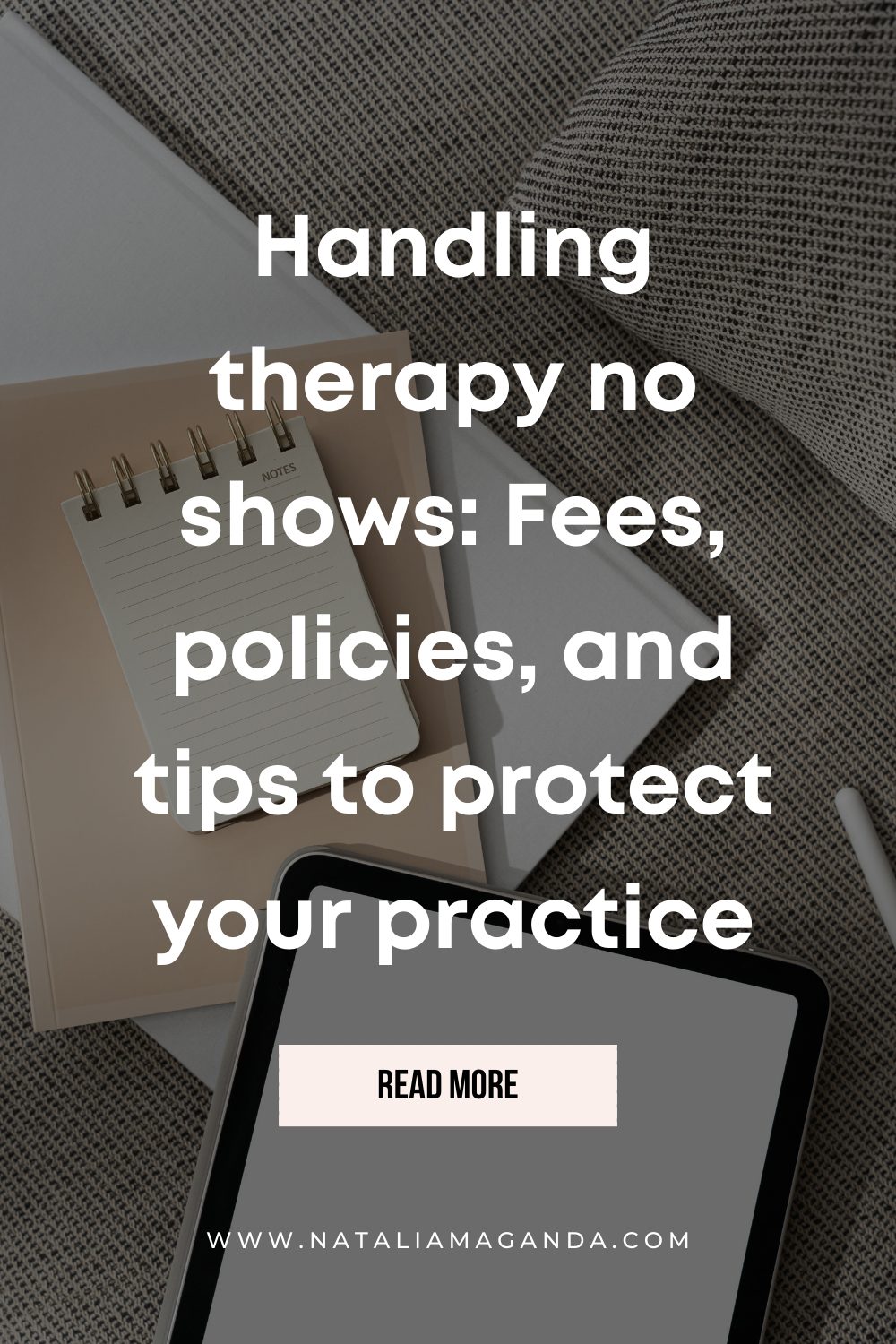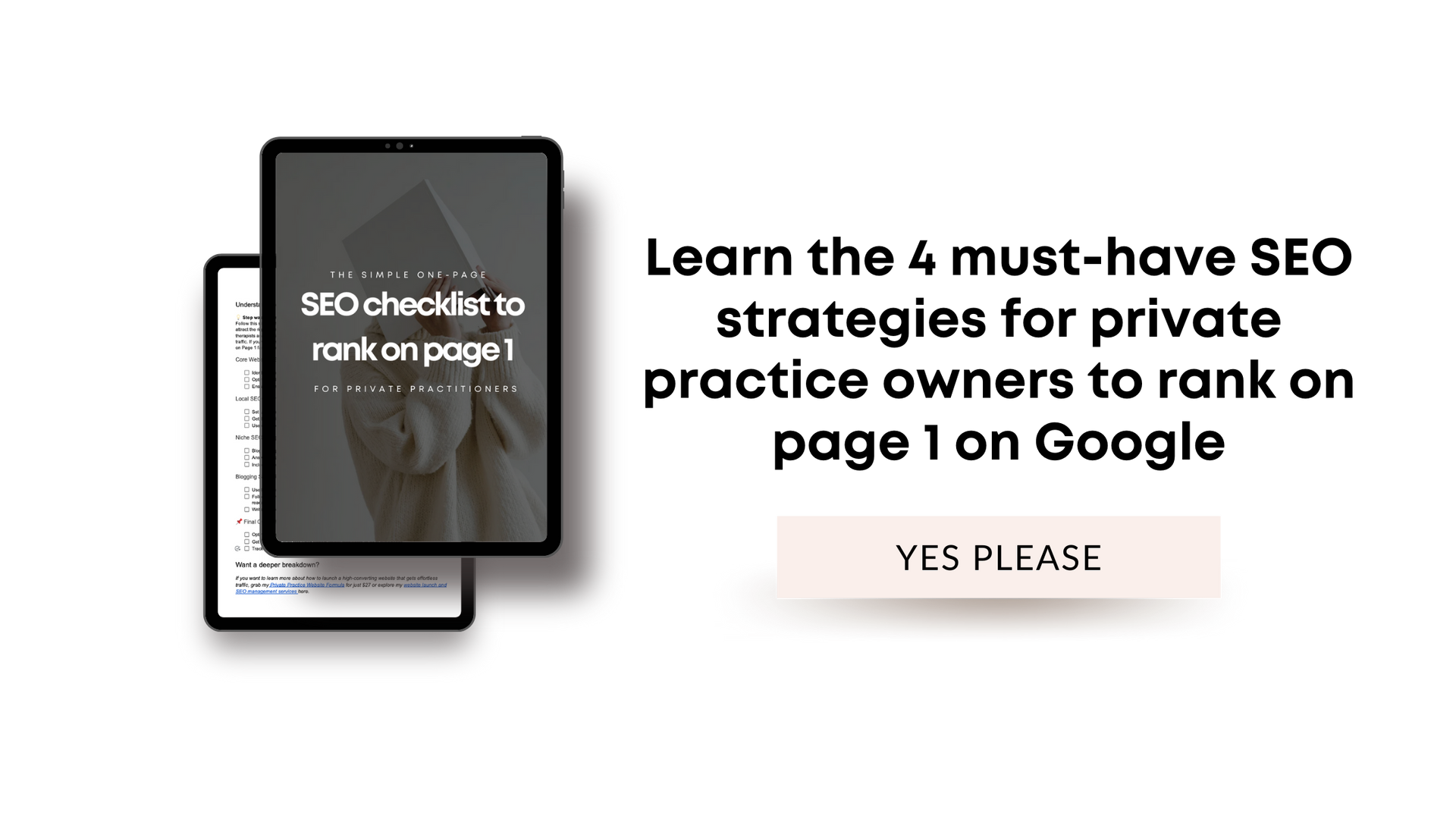Handling therapy no shows: Fees, policies, and tips to protect your practice
Your day is packed, you’re ready to dive into a session, and...your client doesn’t show. No call, no email—just you, staring at your calendar wondering where it all went wrong. Therapy no-shows aren’t just annoying; they mess with your income, disrupt your schedule, and let’s be honest—ruin your day.
In case we haven’t met, I’m Natalia Maganda,website designer for therapists. I help ambitious private practice professionals simplify their marketing, amplify their magic, and build websites that attract dream clients—without stealing your weekends.
Let’s face it—no-shows happen to every therapist at some point. But the difference between frustration and confidence is preparation. Having a no-show policy not only protects your time and income but also sets the tone for a professional, respectful client relationship. Combine that with the right tech (hello, automated reminders), and you’ll find yourself with fewer no-shows, less stress, and a practice that runs like a dream.
Setting up an effective therapy no-show policy
Key elements to include in your no-show policy
Your policy should include:
- A clear definition of what counts as a no-show.
- Notice requirements for cancellations (e.g., 24 or 48 hours).
- Fees for missed appointments.
Examples of therapy no-show fee structures
Charging a no-show fee can feel awkward at first, but it’s an important boundary that protects your time and emphasizes the value of the services you provide. Here are some common fee structures therapists use, along with a detailed example to help you implement one in your practice:
Flat Fee for No-Shows
This approach charges a set amount for any missed session, regardless of the session's original cost.
Example: A $50 fee for any appointment missed without 24-hour notice.
Full Session Fee
With this structure, clients are charged the full cost of their scheduled session if they miss it without sufficient notice. This is a strong deterrent and underscores the importance of attending sessions.
Example: A client who misses a $120 session without proper notice would be billed the full $120.
Sliding Scale or Tiered Fee
Some practices adjust no-show fees based on the client’s income level or the frequency of their no-shows.
Example: First no-show is free, but subsequent no-shows incur a $25 fee for clients on a sliding scale or the full session fee for standard clients.
How to communicate your no-show policy to clients
Being upfront about your no-show policy from the beginning sets the tone for a professional and respectful relationship. This doesn’t have to feel harsh or transactional—it’s all about clear communication delivered with empathy. Here’s how to handle it:
Step 1: Include It in Your Onboarding Materials
Ensure your no-show policy is part of the paperwork clients receive before their first session. Make it clear, concise, and easy to understand.
Example:
“Cancellations made less than 24 hours before the scheduled session or missed appointments will incur a $50 fee, as this time has been reserved exclusively for you. Please let us know as soon as possible if you need to reschedule.”
Step 2: Discuss It During Intake or the First Session
Take a moment to walk clients through your policies, including the no-show policy. This gives them a chance to ask questions and reinforces its importance.
Here’s an empathetic script you can use:
“I want to take a moment to go over some of our policies, including our cancellation policy. If you ever need to cancel or reschedule, just let me know at least 24 hours in advance, and we’ll get it sorted. However, if an appointment is missed or canceled last-minute, there is a $50 fee. This helps me keep the practice running smoothly and ensures I can offer that time to someone else in need.”
Step 3: Address It in Reminders and Confirmations
Your automated appointment reminders can also include a brief mention of the policy to gently reinforce it.
Example:
“Reminder: Please let us know at least 24 hours in advance if you need to cancel or reschedule to avoid the no-show fee.”
By communicating your policy clearly and empathetically, clients will understand its purpose and be less likely to feel blindsided if they’re ever charged.
No-show policy template for your practice
Therapy No-Show and Late Cancellation Policy
Effective Date: [Insert Date]
At [Your Practice Name], we are committed to providing quality care and respect for your time. To ensure the smooth operation of our practice and to offer appointments to those in need, we have established the following policy regarding missed appointments and late cancellations.
1. Definition of a No-Show and Late Cancellation
A no-show occurs when a client does not attend their scheduled session without prior notice. A late cancellation occurs when an appointment is canceled less than [24/48 hours] before the scheduled time.
2. No-Show Fee
If you fail to attend your appointment or cancel without sufficient notice, a fee of [Insert Amount, e.g., $50 or the full session fee] will be charged to the card on file. This fee is not covered by insurance and must be paid before the next session.
3. Exceptions
We understand that emergencies and unexpected circumstances happen. If you are unable to attend your session due to an emergency, please contact us as soon as possible. Exceptions to this policy may be made at the therapist’s discretion.
4. How to Cancel or Reschedule
To cancel or reschedule an appointment, please contact us:
- Phone: [Insert Phone Number]
- Email: [Insert Email Address]
- Online Portal: [Insert Link, if applicable]
Cancellations made [24/48 hours] in advance will not incur a fee.
5. Acknowledgment and Agreement
By signing below, you acknowledge that you have read, understood, and agree to comply with the No-Show and Late Cancellation Policy.
Client Name: ________________________
Date: ________________________
Signature: ________________________
Of course, consult with your legal advisor for any extra considerations using this template.
How to reduce no-shows with automation and reminders
Automated reminders via email or text can dramatically reduce no-shows by gently nudging clients to confirm or reschedule in advance.
Platforms like SimplePractice, TherapyNotes, or Jane App allow you to set up reminders, manage scheduling, and track client attendance with ease.
What to say to a client that no-shows
A no-show isn’t always intentional. Start with curiosity: “I noticed you missed our session—are you okay?” This shows care without jumping straight to enforcement.
Example scripts for handling no-show situations
- First instance: “I understand things come up! Just a reminder about our 24-hour cancellation policy.”
- Repeat offender: “I need to enforce the no-show fee as outlined in our agreement.”
When and how to reinforce your policy
If no-shows persist, it may be time to have a direct conversation about whether the client is ready for therapy. Boundaries protect both parties.
Build a smoother, more sustainable practice
No-shows might feel inevitable, but with a clear policy, the right tech, and some proactive communication, they can become rare blips in your day instead of a constant frustration. The same goes for every aspect of your private practice—whether it’s reducing no-shows or launching your online presence. Ready tolaunch your private practice website? With me, you’ll get a website, basic tech stack, and monthly SEO to simplify your marketing efforts and grow your practice with ease.
Related reads therapist marketing:
- Therapist email essentials: How to setup, secure and leverage your inbox
- Is therapy business coaching worth it and when is it right for you
- 10 essential therapist intake questions to connect and build trust
- How to choose a profitable therapy niche to attract higher-paying clients
- How to make $100K as a therapist without seeing 20+ clients a week
- Private practice therapist salary and tips for increasing your income

* AI Disclosure: This content may contain sections generated with AI with the purpose of providing you with condensed helpful and relevant content, however all personal opinions are 100% human made as well as the blog post structure, outline and key takeaways.
* Affiliate Disclosure: Some of the links on www.nataliamaganda.com may contain affiliate links meaning that I will get a commission for recommending products at no extra cost to you.

hello! i'm natalia
Latina, web design expert for mental health professionals.
I help ambitious life coaches, therapists and holistic leaders amplify their magic, gain visibility, and simplify their marketing efforts through strategic web design and content.










